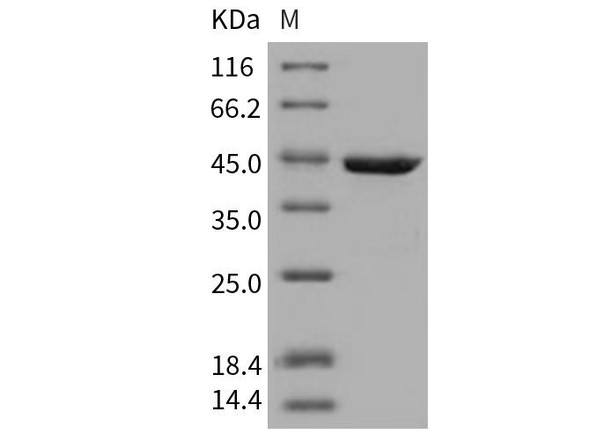Human RAC1 Recombinant Protein (RPPB4377)
- SKU:
- RPPB4377
- Product Type:
- Recombinant Protein
- Species:
- Human
- Uniprot:
- P63000
Description
| Product Name: | Human RAC1 Recombinant Protein |
| Product Code: | RPPB4377 |
| Size: | 50µg |
| Species: | Human |
| Target: | RAC1 |
| Synonyms: | P21-RAC1, RAC-1, RAC1, RAS-like protein TC25, MIG5, Cell-migration-inducing gene 5 protein, rho family small GTP binding protein Rac1, TC-25, MGC111543. |
| Source: | Escherichia Coli |
| Physical Appearance: | Sterile Filtered colorless solution. |
| Formulation: | The protein solution contains 20mM Tris-HCl pH7.5, 2mM EDTA and 1mM DTT. |
| Stability: | Store at 4°C if entire vial will be used within 2-4 weeks. Store, frozen at -20°C for longer periods of time. For long term storage it is recommended to add a carrier protein (0.1% HSA or BSA).Avoid multiple freeze-thaw cycles. |
| Purity: | Greater than 95.0% as determined by SDS-PAGE. |
| Amino Acid Sequence: | MQAIKCVVVGDGAVGKTCLLISYTTNAFPGEYIPTVFDNYSANVMVDGKPVNLGLWDTAQEDYDRLRPLSYPQTDVFLICFSLVSPASFENVRAKWYPEVRHHCPNTPIILVGTKLDLRDDKDTIEKLKEKKLTPITYPQGLAMAKEIGAVKYLECSALTQRGLKTVFDEAIRAVLCP PPVKKRKRKCLLL |
RAC1 is a GTPase which belongs to the RAS superfamily of small GTP-binding proteins. Members of this superfamily appear to regulate a diverse array of cellular events, including the control of cell growth, cytoskeletal reorganization, and the activation of protein kinases. RAC-1 regulates the actin cytoskeleton but also other cellular processes. RAC1 have been shown to be involved in the regulation of cell-cell adhesion.
RAC1 Human Recombinant produced in E.Coli is a single, non-glycosylated polypeptide chain containing 192 amino acids and having a molecular mass of 21.4 kDa.
| UniProt Protein Function: | RAC1: a plasma membrane-associated member of the Rho-GTPase family. Plays a key role in cytoskeletal reorganization, membrane trafficking, transcriptional regulation and cell growth and development. GTP binding stimulates its activity. Phosphorylation by Akt may inhibit GTP binding of Rac1, therefore attenuating the downstream signal transduction pathway. Found in a trimeric complex composed of DOCK1 and ELMO1, which plays a central role in phagocytosis of apoptotic cells. Two alternatively spliced isoforms have been described. |
| UniProt Protein Details: | Protein type:Motility/polarity/chemotaxis; G protein; G protein, monomeric, Rho; G protein, monomeric Chromosomal Location of Human Ortholog: 7p22 Cellular Component: extrinsic to plasma membrane; Golgi membrane; focal adhesion; membrane; lamellipodium; cytoplasm; plasma membrane; melanosome; actin filament; trans-Golgi network; cytosol; phagocytic cup Molecular Function:GTPase activity; protein binding; enzyme binding; GTP binding; GTP-dependent protein binding; Rho GDP-dissociation inhibitor binding; thioesterase binding; protein kinase binding; Rab GTPase binding Biological Process: viral reproduction; nerve growth factor receptor signaling pathway; metabolic process; positive regulation of apoptosis; cell motility involved in cell locomotion; regulation of cell migration; small GTPase mediated signal transduction; positive regulation of stress fiber formation; cell adhesion; bone resorption; platelet activation; anatomical structure morphogenesis; mast cell chemotaxis; dendrite morphogenesis; positive regulation of Rho protein signal transduction; regulation of defense response to virus by virus; negative regulation of interleukin-23 production; T cell costimulation; cerebral cortex radially oriented cell migration; actin cytoskeleton organization and biogenesis; axon guidance; cell-matrix adhesion; localization within membrane; positive regulation of focal adhesion formation; actin filament polymerization; response to wounding; ephrin receptor signaling pathway; inflammatory response; regulation of hydrogen peroxide metabolic process; lamellipodium biogenesis; embryonic olfactory bulb interneuron precursor migration; intercellular junction assembly and maintenance; Wnt receptor signaling pathway, planar cell polarity pathway; positive regulation of phosphoinositide 3-kinase activity; engulfment of apoptotic cell; cell proliferation; G-protein coupled receptor protein signaling pathway; hyperosmotic response; positive regulation of actin filament polymerization; organization of an anatomical structure; auditory receptor cell morphogenesis; ruffle organization and biogenesis; innate immune response; negative regulation of receptor-mediated endocytosis; positive regulation of protein amino acid phosphorylation; vascular endothelial growth factor receptor signaling pathway; blood coagulation; cell motility; positive regulation of DNA replication |
| NCBI Summary: | The protein encoded by this gene is a GTPase which belongs to the RAS superfamily of small GTP-binding proteins. Members of this superfamily appear to regulate a diverse array of cellular events, including the control of cell growth, cytoskeletal reorganization, and the activation of protein kinases. Two transcript variants encoding different isoforms have been found for this gene. [provided by RefSeq, Mar 2009] |
| UniProt Code: | P63000 |
| NCBI GenInfo Identifier: | 51702787 |
| NCBI Gene ID: | 5879 |
| NCBI Accession: | P63000.1 |
| UniProt Secondary Accession: | P63000,O95501, P15154, Q3Y4D3, Q5JAA8, Q9BTB4, |
| UniProt Related Accession: | P63000,AAB22206 |
| Molecular Weight: | 192 |
| NCBI Full Name: | Ras-related C3 botulinum toxin substrate 1 |
| NCBI Synonym Full Names: | ras-related C3 botulinum toxin substrate 1 (rho family, small GTP binding protein Rac1) |
| NCBI Official Symbol: | RAC1�� |
| NCBI Official Synonym Symbols: | MIG5; Rac-1; TC-25; p21-Rac1�� |
| NCBI Protein Information: | ras-related C3 botulinum toxin substrate 1; ras-like protein TC25; cell migration-inducing gene 5 protein |
| UniProt Protein Name: | Ras-related C3 botulinum toxin substrate 1 |
| UniProt Synonym Protein Names: | Cell migration-inducing gene 5 protein; Ras-like protein TC25; p21-Rac1 |
| Protein Family: | Ras-related protein |
| UniProt Gene Name: | RAC1�� |
| UniProt Entry Name: | RAC1_HUMAN |










